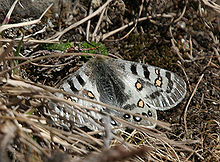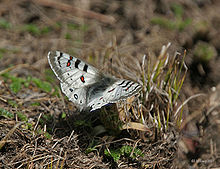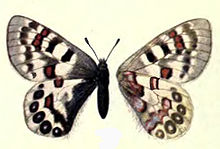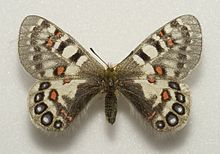- Parnassius hardwickii
-
Common Blue Apollo 
At Biskeri Ridge (13,800 ft.) in Kullu Distt. of Himachal, India Scientific classification Kingdom: Animalia Phylum: Arthropoda Class: Insecta Order: Lepidoptera Family: Papilionidae Genus: Parnassius Species: P. hardwickii Binomial name Parnassius hardwickii
Gray, 1831Common Blue Apollo Parnassius hardwickii is a high altitude butterfly which is found in South Asia. It is a member of the Snow Apollo genus Parnassius of the Swallowtail (Papilionidae) family. This butterfly is found from Chitral to Sikkim and is found from 6000 ft to 17,000 ft, making it one of the most commonly encountered species of Apollo in India.
Contents
Description
- See glossary for terms used
Male upperside creamy-white. Fore wing : base and costal margin densely irrorated with black scales ; a broad short velvety black bar across middle of cell, another along the discocellulars and a third beyond apex of cell, this last with superposed spots of crimson where the bar crosses the bases of interspaces 5 and 8 ; a crimson-centred black spot in middle of interspace 1; an irregularly curved prominent postdiscal series of dusky-black spots, so arranged as to leave a narrow edging of the creamy-white ground-colour beyond, which is traversed by the black veins; the upper four spots of the postdiscal series fused to form a broad, continuous, but short, curved band; the terminal margin broadly dusky black ; the cilia white. Both the dusky-black band and the postdiscal dusky-black markings sub-hyaline. Hind wing: base and dorsal margin broadly dusky black, the inner margin of the black coloration on the latter deeply but irregularly bi-emarginate; a crimson-centred black spot near base of interspace 5, another just beyond the middle of interspace 7, followed by a very conspicuous curved postdiscal series of five dull blue ocelli ringed with black and centred with white, and a narrow diffuse dusky black terminal band; cilia as in the fore wing. Underside: similar, with a glassy appearance. Fore wing: with the markings of the upperside visible by transparency; the white scaling of the upperside replaced by scale-like hairs of the same colour; the only scaled markings are the medial and apical transverse black bars in cell, three small crimson spots beyond and the black-encircled crimson spot in middle of interspace 1. Hind wing: the white scaling along the basal half of the costal margin nearly as on the upperside, the rest hair-like as on the underside of the fore wing; a broad basal band of four crimson or vermilion-red spots followed by a discal irregular series of five similarly-coloured spots, the lower three formed into a short obliquely transverse band above the tornal angle; all the crimson spots encircled more or less obsoletely by black rings, and the following prominently centred with white: the spot in interspaces 2 and 5 and the basal and medial spots in interspace 7.
Female similar; the dusky black irroration on the upperside of the fore wing more extensive and formed into a narrow irregular band below the cell, which runs between the crimson spots beyond the cell-apex and the crimson spot in interspace 1; the crimson spots are larger, with an additional spot in interspace 6 of the fore wing and a pretornal spot on the hind wing. Underside: similar to that of the male but all the red spots much larger and with white scaling in the centre. Antennae nearly black, with only a few white specks, head with brownish-yellow pubescence; rest of the thorax and abdomen covered densely with long white hairs which also clothe, more or less narrowly, the dorsal margin of the hind wing.[1]
Range
Himalayas, Northern India (including Jammu & Kashmir and Sikkim), Pakistan, Nepal, Tibet and China.
Status
Not known to be threatened.[2]
Cited references
- ^ Bingham, C. T. 1907. Fauna of British India. Butterflies. Volume 2
- ^ Collins, N.M., Morris, M.G. (1985) Threatened Swallowtail Butterflies of the World. IUCN. ISBN 2-88032-603-6
Other references
- Sakai S., Inaoka S., Toshiaki A., Yamaguchi S., Watanabe Y., (2002) The Parnassiology. The Parnassius Butterflies, A Study in Evolution, Kodansha, Japan. ISBN 4-06-124051-X
- Weiss J.-C., (1999) Parnassiinae of the World - Part 3, Hillside Books, Canterbury, UK. ISBN 0-9532240-2-3
See also
Categories:
Wikimedia Foundation. 2010.




